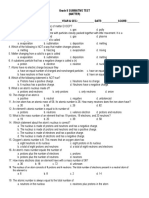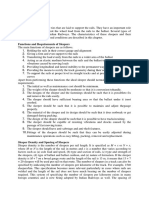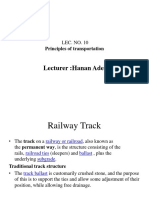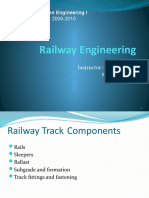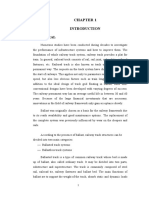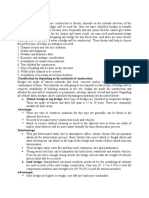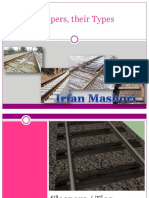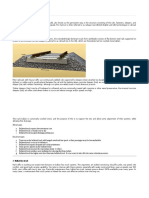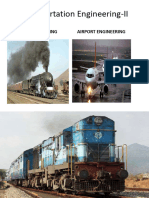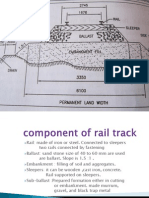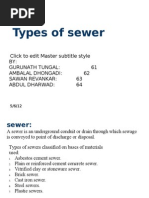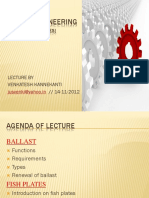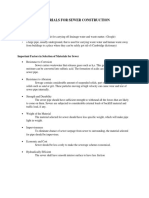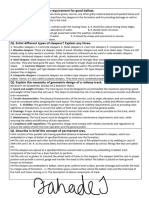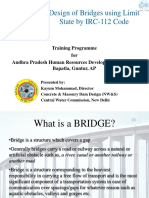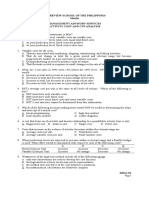Advantages of Steel Sleepers
Advantages of Steel Sleepers
Uploaded by
mustafa engineerCopyright:
Available Formats
Advantages of Steel Sleepers
Advantages of Steel Sleepers
Uploaded by
mustafa engineerOriginal Title
Copyright
Available Formats
Share this document
Did you find this document useful?
Is this content inappropriate?
Copyright:
Available Formats
Advantages of Steel Sleepers
Advantages of Steel Sleepers
Uploaded by
mustafa engineerCopyright:
Available Formats
Steel sleepers
They are in the form of steel trough inverted on which rails are fixed
directly by keys or nuts and bolts and used along sufficient length of tracks.
Advantages of Steel Sleepers
1. Have a useful life of 20-25 years.
2. Free from decay and are not attacked by vermins
3. Connection between rail and sleeper is stronger
4. Connection between rail and sleeper is simple
5. More attention is not required after laying
6. Having better lateral rigidity
7. Good scrap value
8. Suitable for high speeds and load
9. Easy to handle
10. Good resistance against creep
Disadvantages of Steel sleepers
1. Liable to corrosion by moisture and should not because in salty
regions
2. Good insulators and hence cannot be used in track circuited regions
3. Cannot be used for all sections of rails and gauges
4. Should not be laid with any other types of ballast except store
5. Very costly
6. Can badly damage under derailments
7. Way gauge is obtained if the keys are over driven
8. The rail seat is weaker
9. Having good shock absorber as there is not cushion between rail foot
and ballast
Non-ballasted Track
Non-ballasted track, also called ballastless track, is the railway
track whose bed is composed of concrete and bituminous
mixture, etc. Generally, non-ballasted track is made up of steel
rail, railway fasteners and slab. Non-ballasted track’s railway
sleeper is formed by concrete casting. Instead of ballast bed,
steel rail and railway sleeper is laid on the concrete track. There
is no doubt that non-ballasted track is the advanced track
technology in the world. Slab track is one of the most important
types of non-ballast track structure.
Advantages
Non-ballasted track need less maintenance, save cost.
Non-ballasted track can reduce dust and beautify the
environment.
Non-ballasted track has great ride performance and stability.
Non-ballasted track has long durability and service life
(about 50-60yrs).
Non-ballasted track has high train speed and make passengers
feel comfortable.
Disadvantages
Non-ballasted need more investment cost than ballasted track.
Non-ballasted track cannot be laid in some area like clay deep
cutting, soft dirt road and earthquake area.
The most serious drawback of non-ballasted track is that
possibilities for improvement are limited.
Ballast Track
Advantages
Ballasted track requires low investment cost.
Ballasted track is usually easy to lay.
Ballasted track has good drainage performance.
Disadvantages
Train run on the ballasted track with banged sound and low
speed. So that, passengers may feel uncomfortable.
Ballasted track is easy to be deformed.
Ballasted bed requires frequent and costly maintenance.
Train speed is limited on the ballasted track.
Ballasted track has poor life expectation (about 15-20yrs).
Ballasted track produce more pollution by releasing dust from
ballast.
Ballasted track has higher noise level than non-ballasted track.
It is necessary to take effective noise reduction measures.
You might also like
- Deed of Sale of Parcel of Lot Leila DacayananDocument3 pagesDeed of Sale of Parcel of Lot Leila Dacayananbhem silverio100% (2)
- Sleepers in Railway EngineeringDocument48 pagesSleepers in Railway EngineeringAnonymous zAoKLFG100% (1)
- Grade 8 Summative Test (Matter) NAME: - YEAR & SEC.: - DATE: - SCOREDocument3 pagesGrade 8 Summative Test (Matter) NAME: - YEAR & SEC.: - DATE: - SCOREmenchie ismaelNo ratings yet
- Ballast and Non-Ballast in RailwayDocument3 pagesBallast and Non-Ballast in RailwayJhon David Butar-butarNo ratings yet
- Unit 2 Railway EngineeringDocument16 pagesUnit 2 Railway EngineeringHanamant HunashikattiNo ratings yet
- Railway StructureDocument4 pagesRailway StructureJude Patrick BausingNo ratings yet
- Types of Railway SleepersDocument4 pagesTypes of Railway SleepersAtish KumarNo ratings yet
- Railway SleepersDocument34 pagesRailway SleepersMJ MJNo ratings yet
- Railways and SubwaysDocument31 pagesRailways and SubwaysPRINCE HOPE MEDIA TZNo ratings yet
- Sleepers For Railway TrackDocument14 pagesSleepers For Railway TrackChukhu Aane DuiNo ratings yet
- Lecturer:Hanan Adel: Principles of TransportationDocument17 pagesLecturer:Hanan Adel: Principles of TransportationAlaraqi AlaraqiNo ratings yet
- Elements of Railway TracksDocument8 pagesElements of Railway TracksKhalid Yousaf100% (2)
- Ballastless TrackDocument22 pagesBallastless TrackCTR KMRLNo ratings yet
- SS SleepersDocument6 pagesSS SleepersManoj BhutaniNo ratings yet
- Railway Engineering: Spring Semester 2009-2010Document35 pagesRailway Engineering: Spring Semester 2009-2010Narendra ShahNo ratings yet
- SleepersDocument37 pagesSleepersKhalil AhmedNo ratings yet
- Module 2 - Wastewater NotesDocument31 pagesModule 2 - Wastewater Notessureshtm1203No ratings yet
- Slab TrackDocument4 pagesSlab TrackVemmy KurniawanNo ratings yet
- Wastewater NotesDocument34 pagesWastewater Notesdeekshith gowdaNo ratings yet
- 1.1 GeneralDocument22 pages1.1 GeneralshahzilezNo ratings yet
- Forest En. 2 (Half)Document7 pagesForest En. 2 (Half)kazi Al Muqtadir AbirNo ratings yet
- Sewer ShapesDocument11 pagesSewer ShapesShashank BhardwajNo ratings yet
- Rajlway RoadDocument29 pagesRajlway Roadjhshj834No ratings yet
- UNIT-3 (Lecture-4) Expansion JointsDocument38 pagesUNIT-3 (Lecture-4) Expansion JointsSabbir hossainNo ratings yet
- Sleepers, Their TypesDocument42 pagesSleepers, Their TypesGulzar HussainNo ratings yet
- Track StructureDocument4 pagesTrack StructureHarsha Vardhan MeduriNo ratings yet
- Advantages and Disadvantages of Different Type of PilesDocument3 pagesAdvantages and Disadvantages of Different Type of PilesCotangent TwoPiNo ratings yet
- Component Parts of A Railway Track StructureDocument46 pagesComponent Parts of A Railway Track Structuretesfaye wondimuNo ratings yet
- Components of RailwayDocument10 pagesComponents of RailwayRitwik PoddarNo ratings yet
- Airport EngineeringDocument164 pagesAirport Engineeringanand100% (1)
- BS 131 Dated 24 11 2021Document14 pagesBS 131 Dated 24 11 2021Ramesh Gupta100% (1)
- Introduction of RailwayDocument16 pagesIntroduction of Railwaysohampinak80No ratings yet
- Advantages and Disadvantages of Rigid PavementDocument1 pageAdvantages and Disadvantages of Rigid PavementGelo Dizon100% (1)
- Lec 3 SleepersDocument21 pagesLec 3 Sleepershaidarullah0060116No ratings yet
- Under Carriage of Construction EquipmentDocument19 pagesUnder Carriage of Construction EquipmentBhawesh SthaNo ratings yet
- Compare Ballasted Track and Slab TrackDocument2 pagesCompare Ballasted Track and Slab TracktajuddinmyNo ratings yet
- Structure of Literature ReviewDocument7 pagesStructure of Literature ReviewTulikaBoseNo ratings yet
- Chapter ThreeDocument17 pagesChapter Threecheryeassefa2015No ratings yet
- Lec-2, RailsDocument25 pagesLec-2, Railshaidarullah0060116No ratings yet
- Railway SleepersDocument22 pagesRailway SleepersPiyush Bhandari0% (1)
- CivEng Georg Wolff - Railway Bridge Design Important Items For Long Life SpanDocument62 pagesCivEng Georg Wolff - Railway Bridge Design Important Items For Long Life SpanJeerawatNo ratings yet
- Types of SewerDocument14 pagesTypes of SewerAmbalal DhongadiNo ratings yet
- Unit-I Railway Engineering: Ballast & Fishplates)Document39 pagesUnit-I Railway Engineering: Ballast & Fishplates)Gopi RajuNo ratings yet
- Pipe Materials and Specifications: Common Materials Used For Pipes AreDocument12 pagesPipe Materials and Specifications: Common Materials Used For Pipes ArePrashantNo ratings yet
- Effective Methods For Mounting Rail Systems On Concrete FoundationsDocument7 pagesEffective Methods For Mounting Rail Systems On Concrete FoundationsCalva BarreraNo ratings yet
- CE 5154 Introduction To Bridge EngineeringDocument115 pagesCE 5154 Introduction To Bridge EngineeringDavid Gómez de la TorreNo ratings yet
- Materials For Sewer ConstructionDocument5 pagesMaterials For Sewer ConstructionJonniel De GuzmanNo ratings yet
- Sleepers & Fittings (Unit 1)Document41 pagesSleepers & Fittings (Unit 1)Hanamant HunashikattiNo ratings yet
- Effective Methods For Mounting Rail Systems On Concrete FoundationsDocument7 pagesEffective Methods For Mounting Rail Systems On Concrete FoundationsRana Mubbashir IqbalNo ratings yet
- Lecture 1 Introduction To Pavement Design23.01.2020Document10 pagesLecture 1 Introduction To Pavement Design23.01.2020GriffithsNo ratings yet
- Rails, Creep, Failures, Joints and Welding: Prepared by Khushbu Bhatt Parul University VadodaraDocument163 pagesRails, Creep, Failures, Joints and Welding: Prepared by Khushbu Bhatt Parul University VadodaraKaushal MehtaNo ratings yet
- Permanent Way Component PartsDocument39 pagesPermanent Way Component PartsFarooq Maniyar100% (1)
- Kuliah1 p9 38Document30 pagesKuliah1 p9 38luhsintya psdNo ratings yet
- Tranport Iqbal Sir MergedDocument282 pagesTranport Iqbal Sir MergedRezwan NiloyNo ratings yet
- Rail Unlocked PDFDocument115 pagesRail Unlocked PDFsh tanimNo ratings yet
- Presentation On BallastDocument20 pagesPresentation On BallastShivam Srivastava100% (4)
- SMNR-RPRT Ballastless TrackDocument19 pagesSMNR-RPRT Ballastless Trackgreeshma cNo ratings yet
- Infrastructure FJDocument17 pagesInfrastructure FJSamarth DetheNo ratings yet
- Design of Bridges Using Limit State by IRC-112 CodeDocument45 pagesDesign of Bridges Using Limit State by IRC-112 CodeTIRTH100% (1)
- A Short Guide to the Types and Details of Constructing a Suspension Bridge - Including Various Arrangements of Suspension Spans, Methods of Vertical Stiffening and Wire Cables Versus Eyebar ChainsFrom EverandA Short Guide to the Types and Details of Constructing a Suspension Bridge - Including Various Arrangements of Suspension Spans, Methods of Vertical Stiffening and Wire Cables Versus Eyebar ChainsNo ratings yet
- Key Functions of A WMSDocument4 pagesKey Functions of A WMSRazeen AmeenNo ratings yet
- BIÊN DỊCH 3Document39 pagesBIÊN DỊCH 3Huynh Minh KyNo ratings yet
- Wallkill Hose Company Audit ReportDocument19 pagesWallkill Hose Company Audit ReportDaily FreemanNo ratings yet
- Part B - Health Facility Briefing & Design 157Document27 pagesPart B - Health Facility Briefing & Design 157John Dryden Pillos ClerigoNo ratings yet
- Momen InersiaDocument13 pagesMomen InersiaHendra DoankNo ratings yet
- Series 33X: Piezoresistive Pressure Transmitters With Maximum Accuracy of 0,01 %FSDocument9 pagesSeries 33X: Piezoresistive Pressure Transmitters With Maximum Accuracy of 0,01 %FSmuhammetnaberNo ratings yet
- Oracle Apps Technical ConsultantDocument4 pagesOracle Apps Technical Consultantswaroop gcNo ratings yet
- PDF Spry User Manual DLDocument23 pagesPDF Spry User Manual DLSyafrullahNo ratings yet
- Santa Monica Institute of Technology Andrada Bldg. Cabili Avenue. Iligan CityDocument2 pagesSanta Monica Institute of Technology Andrada Bldg. Cabili Avenue. Iligan CityCHAPEL JUN PACIENTE100% (2)
- Coc Level 1-4Document149 pagesCoc Level 1-4eferem100% (14)
- Module 2 English For International EmploymentDocument4 pagesModule 2 English For International EmploymentGalvez, Princess May J.No ratings yet
- Chap 7 Additional Aspects of Aqueous EquilibriaDocument45 pagesChap 7 Additional Aspects of Aqueous EquilibriaLương Ng Ngọc TânNo ratings yet
- JavaScript Bangla Book PDFDocument101 pagesJavaScript Bangla Book PDFrayhan ahmed33% (18)
- Veneration Without Understanding by Renato ConstantinoDocument2 pagesVeneration Without Understanding by Renato ConstantinoCARLOS NORIEL CABANANo ratings yet
- Natural Resources and Conservation in South Africa GR 7Document18 pagesNatural Resources and Conservation in South Africa GR 7selloselowa6No ratings yet
- Voltage Shunt FeedbackDocument6 pagesVoltage Shunt FeedbackSayan Kumar KhanNo ratings yet
- MSQ-01 - Activity Cost & CVP Analysis (Final)Document11 pagesMSQ-01 - Activity Cost & CVP Analysis (Final)Mary Alcaflor50% (6)
- Sulfur Certified Reference Materials: ISO/IEC 17025 and ISO/IEC 17034Document15 pagesSulfur Certified Reference Materials: ISO/IEC 17025 and ISO/IEC 17034Sarbast KhoshnawNo ratings yet
- FI - Overview of Cross Currency Swaps Via Swap PricerDocument59 pagesFI - Overview of Cross Currency Swaps Via Swap PricerDao QuynhNo ratings yet
- Thinkpad X260 Hardware Maintenance ManualDocument106 pagesThinkpad X260 Hardware Maintenance ManualArya AryaNo ratings yet
- (WWW - Asianovel.com) - The Viridescent Crown 3-30Document245 pages(WWW - Asianovel.com) - The Viridescent Crown 3-30kemberly Manila0% (1)
- Form Deakin International Scholarship Program A4 2019 UpdatedDocument2 pagesForm Deakin International Scholarship Program A4 2019 UpdatedYared MogesNo ratings yet
- Introduction To AmplifiersDocument25 pagesIntroduction To Amplifiersrahul prasadNo ratings yet
- Angel Number 215 Meaning Respect The Nature - Su 2Document2 pagesAngel Number 215 Meaning Respect The Nature - Su 2Jacky D.No ratings yet
- bd135 954513Document10 pagesbd135 954513cjtrybiecNo ratings yet
- Additive Manufacturing of NiTi Shape Memory AlloyDocument16 pagesAdditive Manufacturing of NiTi Shape Memory AlloyOğuz Baran ÖzgözgüNo ratings yet
- Achievement Test #5 (Động Từ Khiếm Khuyết Và Gerund & Infinitive) (Key)Document5 pagesAchievement Test #5 (Động Từ Khiếm Khuyết Và Gerund & Infinitive) (Key)RioPhanNo ratings yet
- SOR Volume 3 Road (Required For Estimation and Costing)Document124 pagesSOR Volume 3 Road (Required For Estimation and Costing)Vaibhav Sharma100% (4)


